- News
- Reviews
- Bikes
- Components
- Bar tape & grips
- Bottom brackets
- Brake & gear cables
- Brake & STI levers
- Brake pads & spares
- Brakes
- Cassettes & freewheels
- Chains
- Chainsets & chainrings
- Derailleurs - front
- Derailleurs - rear
- Forks
- Gear levers & shifters
- Groupsets
- Handlebars & extensions
- Headsets
- Hubs
- Inner tubes
- Pedals
- Quick releases & skewers
- Saddles
- Seatposts
- Stems
- Wheels
- Tyres
- Tubeless valves
- Accessories
- Accessories - misc
- Computer mounts
- Bags
- Bar ends
- Bike bags & cases
- Bottle cages
- Bottles
- Cameras
- Car racks
- Child seats
- Computers
- Glasses
- GPS units
- Helmets
- Lights - front
- Lights - rear
- Lights - sets
- Locks
- Mirrors
- Mudguards
- Racks
- Pumps & CO2 inflators
- Puncture kits
- Reflectives
- Smart watches
- Stands and racks
- Trailers
- Clothing
- Health, fitness and nutrition
- Tools and workshop
- Miscellaneous
- Buyers Guides
- Features
- Forum
- Recommends
- Podcast
TECH NEWS
Tour Tech 2013: The time trial bikes
It’s the team time trial in the Tour de France today so let’s have a look at some of the bikes the riders will be racing on.
We were in Corsica last week ahead of the Grand Départ and many teams were out making adjustments to their set-ups and getting their race strategy sorted. Here are the bikes that we spotted the mechanics working on back at the team hotels…
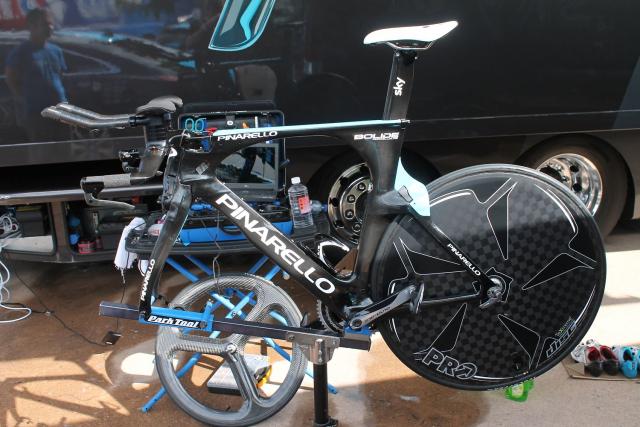
Team Sky are riding the time trials on Pinarello’s new Bolide which debuted in the Giro d’Italia – you might remember Wiggins rode it, had a mechanical problem, and ditched it. Here’s Vasil Kiryienka trying out his Bolide set-up.
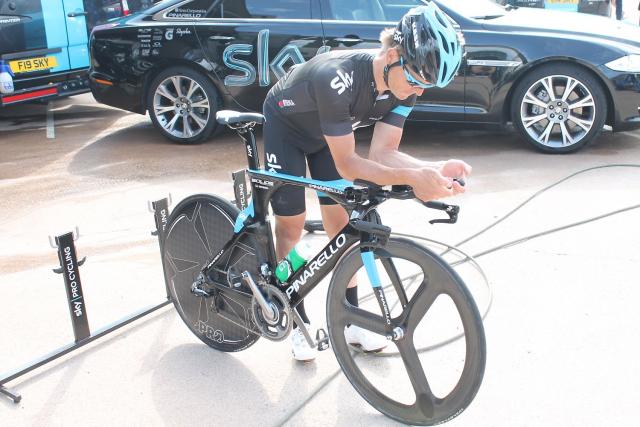
One of the most interesting features is that the brakes are completely covered. You might think that the design would fall foul of this UCI ruling: “1.3.024 Any device, added or blended into the structure, that is destined to decrease, or which has the effect of decreasing, resistance to air penetration or artificially to accelerate propulsion, such as a protective screen, fuselage form fairing or the like, shall be prohibited."
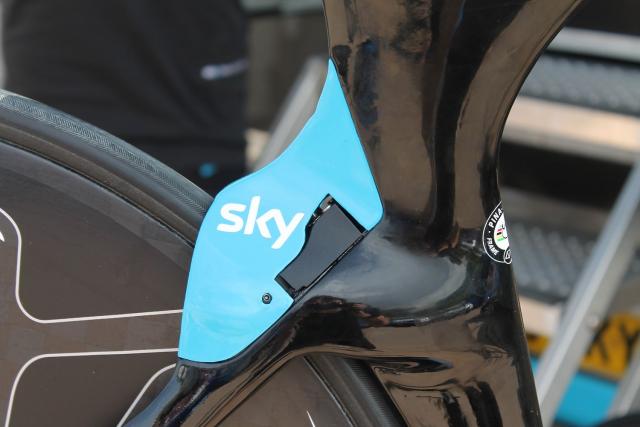
If you did think that, you’d be wrong, because the UCI have issued a ‘clarification’ concerning this ruling: "The addition of a cover to a braking system… is authorised. The unit is considered to be integrated with the frame or fork.”
How that’s a clarification rather than an outright contradiction is anyone’s guess. The UCI have a bunch of differently sized 'boxes' that different frame elements have to fit into. If they're withing the limits they're allowed, regardless of that rule above.

All of the Team Sky riders run Shimano Dura-Ace Di2 on their TT bikes, with shifters on both the base bar and the aero extensions. Some use Shimano’s R671 bar-end shifters with upshift and downshift buttons on each unit, while others use the 9071 shifters (below) with a single button.
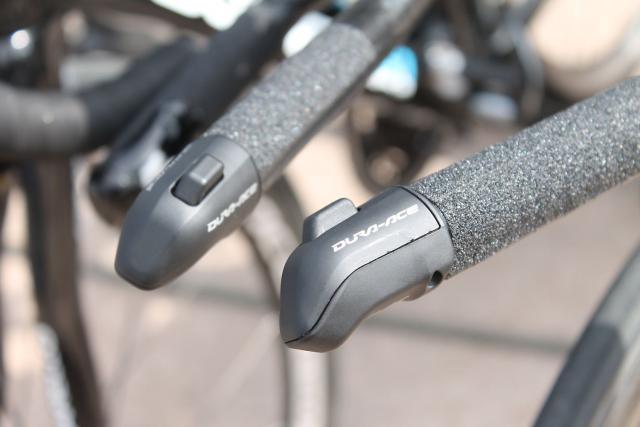
With the 9071, one unit controls upshifts on the cassette, the other downshifts – the only way of switching chainrings is via the shifter on the base bar. The base bar shifters are Pinarello’s own design. See more Team Sky bike pics in our Team Sky gallery.
We covered the Bolide again last week so we won’t go over the same ground again here. Check out our previous story.

Spanish outfit Movistar are on Pinarellos too, but this time it’s the new Sibilo. Hang on! Didn’t we just say that the Bolide was Pinarello’s new time trial bike? Ah, well, they’ve launched two top-end TT bikes this year; we’ve never really got to the bottom of that unusual strategy. It could be that the Bolide was developed with input from Team Sky, although that's just speculation.

Anyway, the Sibilo – this is Alejandro Valverde’s bike – has airfoil shaped tubes and brakes that are covered by fairings. Oops! Sorry, no, not fairings. They’re something else. Unlike the Bolide, the Sibilo’s rear brake is positioned behind the bottom bracket.

Pinarello have gone with an external fork steerer to keep things as aero as possible up front, and they’ve developed the slinky-looking bar/stem with Vision. They’ve also specced a BB86 press-fit bottom bracket rather than a threaded version like they use on most of their other bikes.
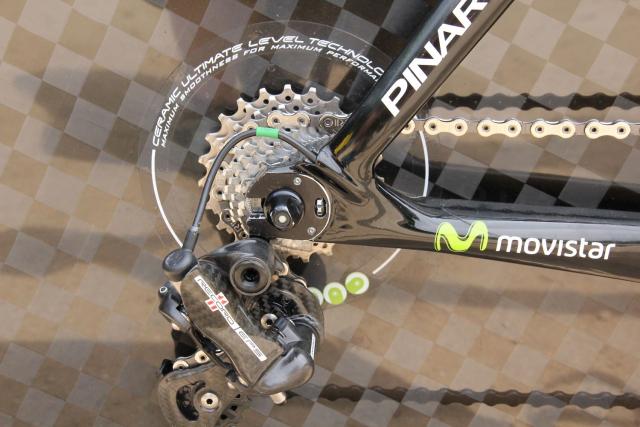
As you can see, Movistar are on Campagnolo EPS electronic shifting – they were the first team to get it. Interestingly, most of the team bikes we saw that were running EPS had the Record version rather than the even higher-end Super Record. Campag supply the wheels too. See more pics in our Movistar Pinarello Sibilo gallery.
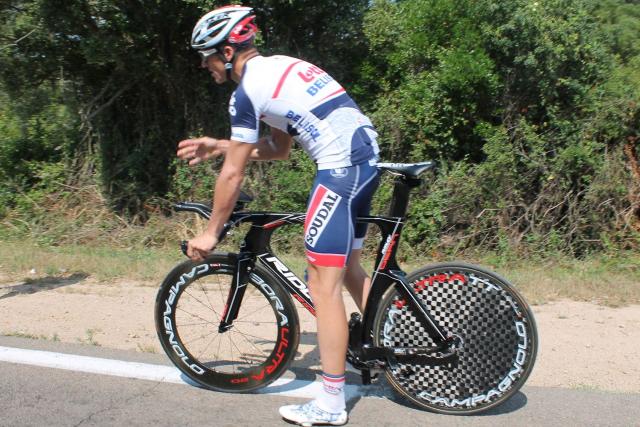
Lotto Belisol (main pic) are on the new Ridley Dean Fast time trial bike, successor to the Ridley Dean.
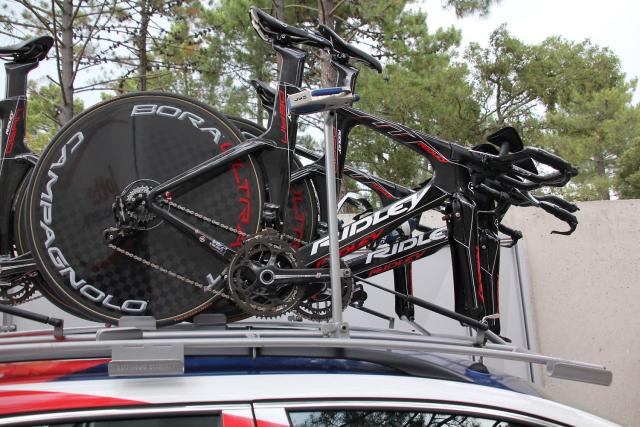
The Dean Fast uses Ridley’s F-Split fork where the legs comprise two parts with a gap down dividing them. The idea is that this ‘twin foil design’ guides the airflow away from the spokes to reduce drag at the front wheel.
The bike also features a refinement of Ridley’s F-brake which is now operated by a centre-pull mechanism with the cabling hidden inside the head tube. The brake arms are sheltered at the back of the fork.
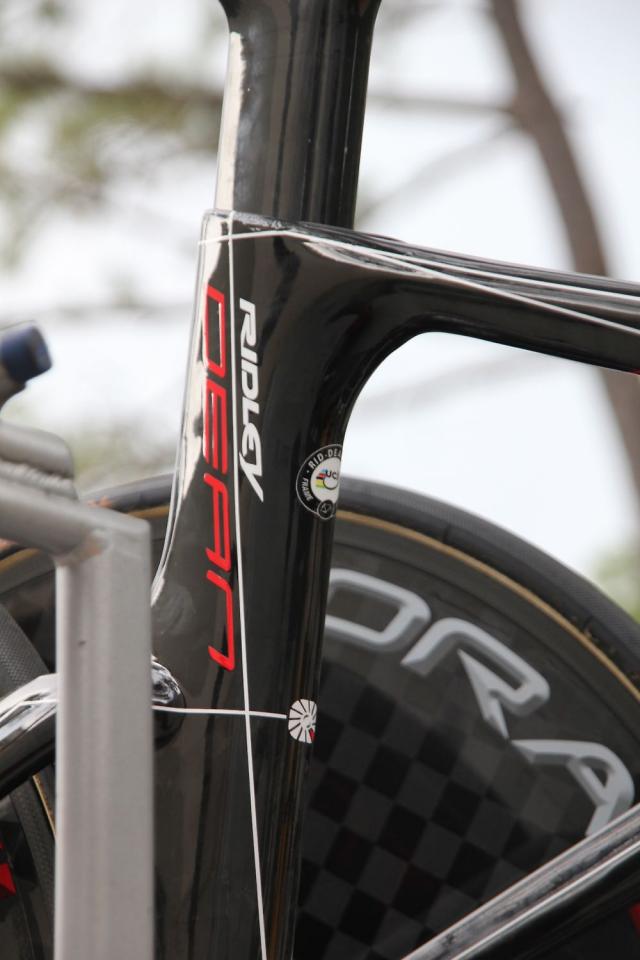
Ridley make a lot of the F-Surface that they add to the tubes. It gives a finish that looks a little like coarse sandpaper. In Ridley’s own words, it is “a special surface texture that deliberately creates micro turbulences at the boundary layer which improves the laminar flow effect, keeping the airflow as close to the surface as possible. This dramatically reduces drag.”
The F-Surface was previously applied on to the frame after the bike had been made. Now it is moulded into the down tube and the seat tube.

That fully integrated cockpit is new too, with a stem that flows almost seamlessly into the top tube.
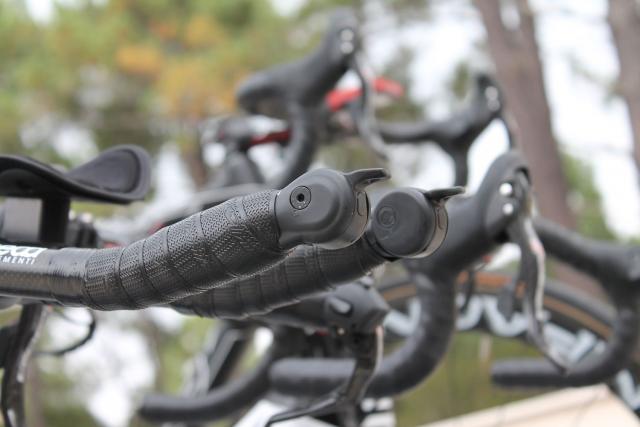
Lotto Belisol use Campagnolo EPS electronic shifting on their TT bikes. Unlike Shimano’s button-operated Di2 designs, Campag have stayed with a lever that sticks out the front of the aero extensions.
The EPS battery is mounted on the down tube, just in front of the bottom bracket, although Campag are currently working on an internal battery which the Ridley Dean Fast is capable of taking, so the team riders will presumably swap over when it becomes available.
Sticking with Campag, Lotto Belisol are using Bora Ultra wheels while they go to Deda for their bars. We have a load more pics of theses bikes in our gallery.

AG2R-La Mondiale are another team who use Campagnolo groupsets, this time on Focus bikes. We have to say that the Izalco Chrono looks like it’s overdue a redesign. Okay, the frame tubes are very skinny and the head tube does look very short to get the rider into a low and aero ride position, but that standard head tube/headset design and road bike-style stem look a few years out of date in TT terms.
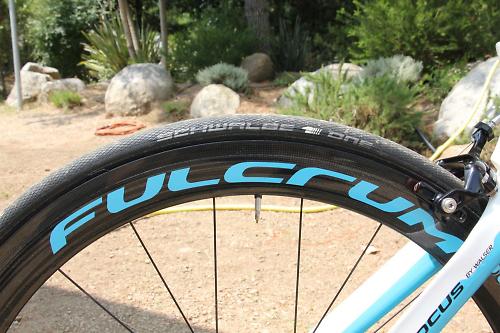
AG2R use Fulcrum wheels – a Campag brand designed to appeal to non-Campag groupset users. The Racing Speed XLRs here come with 50mm deep full-carbon rims and a carbon hub body.
Lots of riders on many teams go for the aero version of Look’s Kéo pedals on their TT bikes. They’re a touch heavier than a standard model but the idea is that they reduce drag a touch.
Fizik have a massive presence in the pro peloton these days, with the TT-specific Ares being a popular choice. It’s much shorter than most other saddles, allowing riders to get into an aero tuck without any excess material and without breaking UCI rules on saddle positioning. For lots more pics of the Focus Chrono check out our AG2R Focus Chrono gallery.
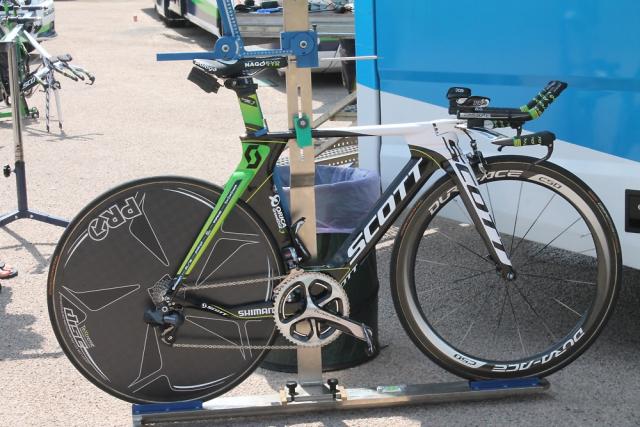
Orica-Green Edge are on Scott Plasmas with the stem and fork crown integrated within the cutaway head tube. The Australian team are almost completely Shimano-ed up with Di2 components and bars and some wheels from Pro, which is a Shimano sub-brand. The only notable exception here is the Prologo saddle. It’s a Nago Evo TTR with an anti-slip cover. Riders aren’t allowed to add grip tape to saddles anymore although manufacturers’ finishes designed to do the same job are permitted.
The Di2 battery placement behind the saddle is unusual, although it looks reasonably well hidden behind the saddle clamp. Most batteries will doubtless be stowed internally soon.

This is the Canyon Speedmax CF belonging to Joaquim Rodriguez of Katusha.
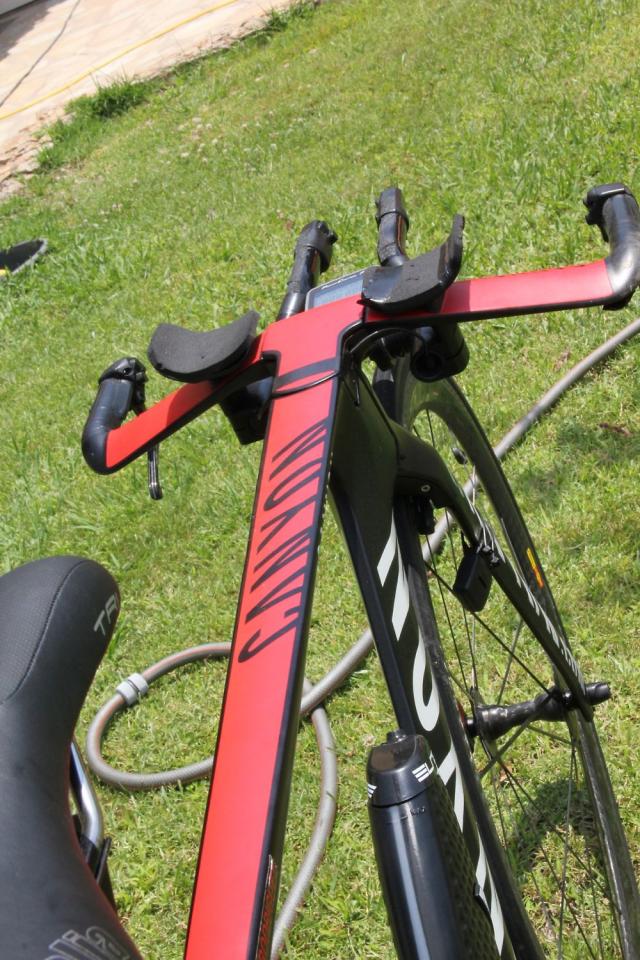
The bike uses what Canyon call Trident tube profiles where the leading edge is curved before becoming more angular with a chopped-off tail. The idea is to reduce drag while adding stiffness compared to most NACA aero shapes, and the relatively shallow tube profiles don’t catch crosswinds in the same way that deeper tubes can.
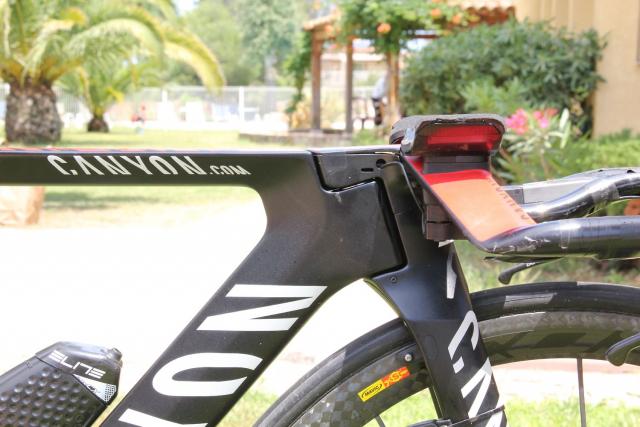
The fork/handlebar/stem design is really neat and there’s barely any cabling in sight. The centre-pull front brake is integrated into the back of the fork while the rear brake sits behind/underneath the bottom bracket. The Speedmax CF is the only bike we can think of that’s Di2 only (let us know below if there are any others that we’ve forgotten).
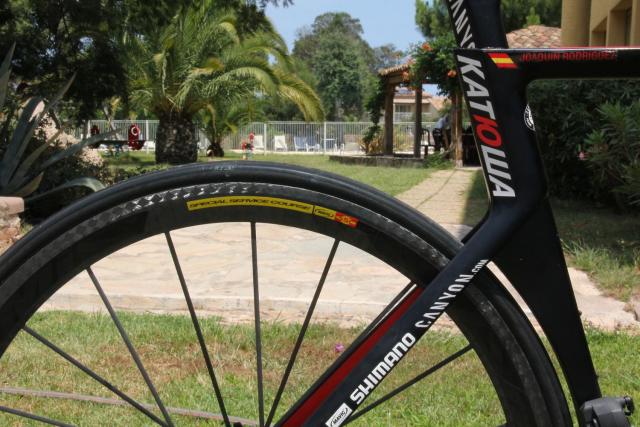
J-Rod uses a Shimano Di2 groupset – which is just as well because that’s all that the Speedmax CF will take. Those look like Mavic Cosmic Carbone Ultimate wheels with 40mm deep rims and Mavic’s Yksion tubs. Visit our gallery for more pics of this bike.
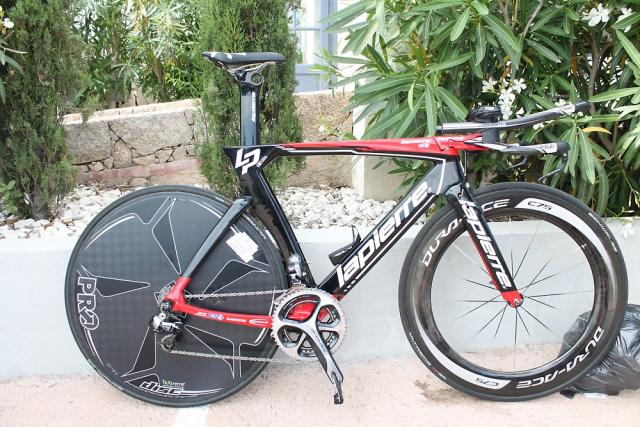
Francaise des Jeux are on Lapierre bikes and this is William Bonnet’s Aerostorm. Check out the front brake… well, you can’t exactly see it because it’s incorporated into the fork.

Very unusually, the cable for the linear-pull brake goes through the top of the fork leg and there’s a little slot in the fork that allows the position of the brake shoe to be adjusted.

FDJ are another Shimano-equipped team, all of their TT bikes rocking a Dura-Ace Di2 groupset. As we mentioned above, Pro is a Shimano brand and it provides the disc wheel and the Missile Evo bar set up. Are the mechanics going to chop the back off those extensions? There’s a lot of spare tube there for Bonnet to whack his knees on.
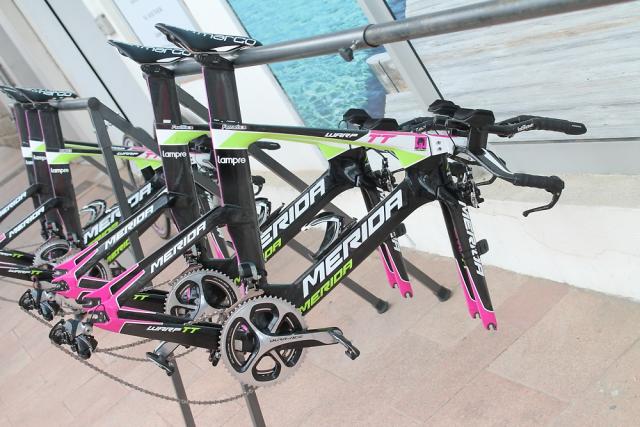
The Lampre-Merida bikes weren’t built up when we want a-calling. We were early birds, see, and went on Wednesday when all the teams were still arriving on Corsica. Anyway, this is the Merida Warp TT sans wheels.
We first showed you this bike back in February when we went out to Merida’s range launch in Majorca. Merida reckon that it’s the most aerodynamically efficient TT bike in the world when the apparent wind is head on, and that it’s in the leading group overall (Merida don’t think you can say that one TT bike is ‘best’ all round).

The head tube is super-short and the stem sits flush with the top tube. Speaking of the stem, it has an internal length adjustment system that allows you to alter the position of the bars, and the cabling runs internally through it.
Lampre use Dura-Ace Di2 but there’s no battery to be seen because it’s tucked away inside the seat tube. The bars are from Vision, which is an FSA brand.
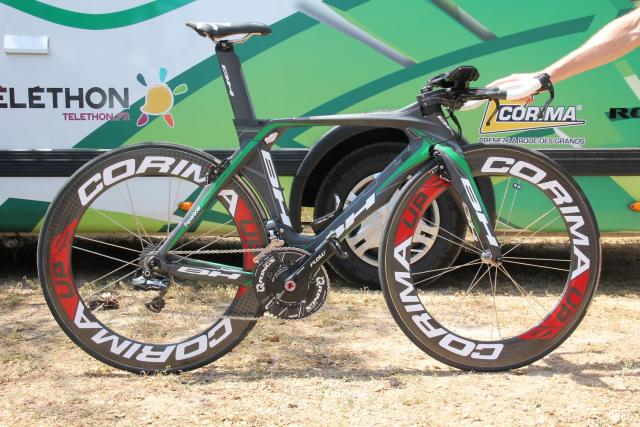
Sojasun are a French Pro Continental team who ride bikes from Spanish brand BH. Their TT bike is the Aerolight that is built with a really short, cutaway head tube so that neither the fork crown nor the stem extend the frame’s frontal area greatly.

The dedicated carbon stem is designed to integrate closely with the frame – as this one does. However, the shortest stem that BH make is 80mm. If a rider wants to run one shorter than that, he has to make do with a standard stem instead which isn’t nearly so neat.
Sojasun are using Shimano Dura-Ace Di2 groupsets although the linear-pull brakes on the Aerolight are from TRP, with the brake arms sitting directly behind the seatstays and the fork legs to reduce drag, and that’s a Rotor chainset with the aerodynamic Flow cranks.
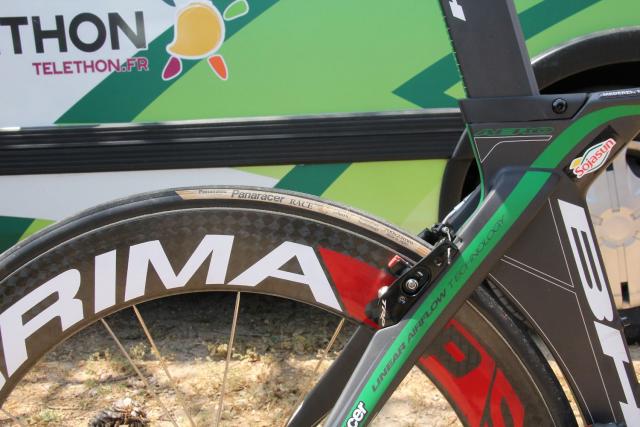
Corima provide the wheels for both Sojasun and Astana. These are the new Up S design with 73mm deep rims.
Mat has been in cycling media since 1996, on titles including BikeRadar, Total Bike, Total Mountain Bike, What Mountain Bike and Mountain Biking UK, and he has been editor of 220 Triathlon and Cycling Plus. Mat has been road.cc technical editor for over a decade, testing bikes, fettling the latest kit, and trying out the most up-to-the-minute clothing. He has won his category in Ironman UK 70.3 and finished on the podium in both marathons he has run. Mat is a Cambridge graduate who did a post-grad in magazine journalism, and he is a winner of the Cycling Media Award for Specialist Online Writer. Now over 50, he's riding road and gravel bikes most days for fun and fitness rather than training for competitions.
Latest Comments
- imajez 25 min 16 sec ago
- looks like someone has fallen for the steel is real markerting BS. I only care how a bike rides, not what it is made of. I had a lovely steel...
- lonpfrb 1 hour 45 min ago
That argument is ignorance of the widespread height and width restrictions to be found on the many minor roads that were originally created for...
- David9694 4 hours 1 min ago
cyclists should be made to have number plates - Interesting police video here of the range of illegal number plates - we'd got, as the caption says...
- rookybiker 5 hours 14 min ago
The trailer seems to connect to both ends of the rear axle. Can it do tight corners without dragging the tyre sideways?
- froze 5 hours 17 min ago
Motorists have always been unkind to cyclists, but distracted driving is adding to the problem....
- Destroyer666 6 hours 10 min ago
Have you owned Bont shoes? In my experience even the widest Lake shoes have had a bizarre form of narrowing way too much in the toe area. But the...
- froze 6 hours 38 min ago
Not sure if this is possible, but this news letter goes out all over the world, and some places like Decathlon does not send stuff to America, in...
- Hirsute 7 hours 23 min ago
I'm confused as to why you'd need bib shorts indoors.
- Oldfatgit 7 hours 51 min ago
I'm sure you were being sarcastic... however ... Lewis Hamilton lives in Monaco. Yet another car driver that doesn't pay any tax





























Add new comment
8 comments
I would say Ridley & Canyon look good. If the Merida had a different paint job it would look better.
Canyon +1
Lapierre -1
Great images of the Time Trial bikes, I wonder if anyone is going to coming out with massive brake shields next.
We have our time trial bikes on sale if you are looking for one Capital Cycles
I rather like the Ridley myself, though agree that the Canyon looks slick, especially with that super flat top tube.
Canyon looks like something from a wartime movie, some French dude trying escape Ze Germans with a load of onions round his neck!!
Great article, thanks. I agree that the Canyon is far and away the best looking of the bunch.
Hideous graphics aside, the Canyon look superb. Evil.
The Canyon is easily the best looking out of all of these, can't wait to see them all in action tomorrow.